Mugwort uses abound! This self-seeding perennial is easy to grow and has many valuable benefits as food and medicine.
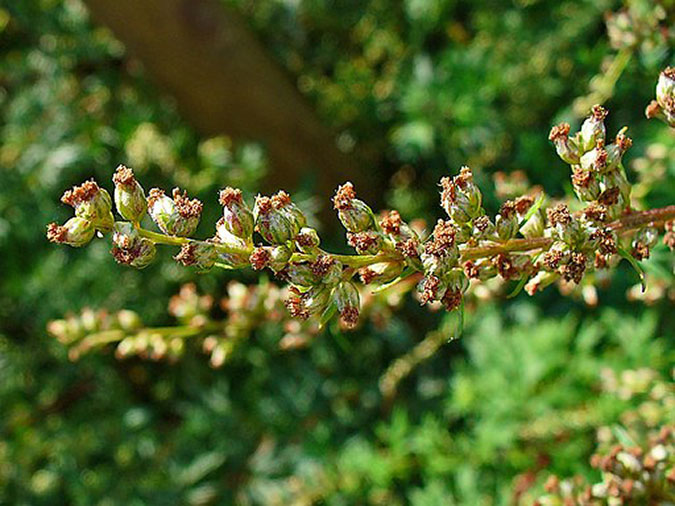
H. Zell, CC BY-SA 3.0, via Wikimedia Commons
For the Love of Mugwort: 7 Mugwort Uses You Need to Know
Mugwort (Artemisia vulgaris) is a divine lady who goes by several names, including wild wormwood, chrysanthemum weed, artemis, Old Uncle Henry, St. John’s plant, and cronewort.
As a simple-to-grow perennial that self-seeds readily, mugwort easily grows to 4 ft. and more. She can grow in all types of soils, including poor and alkaline, but she does prefer good drainage. She can tolerate drought and likes full to part sun.
Identifying Mugwort in the Wild
Her central stem is purplish like the color of a deep Bordeaux wine, while her feathery, deeply divided pinnate1)Pinnate: Literally meaning “resembling a feather.” It can refer to leaflet arrangement or a venation pattern. leaves are dark green on the upper surface and covered with downy hairs reminiscent of the moon’s silvery sheen on the underside.
Her reddish or pale yellow flowers bloom from July to October. Although nondescript, mugwort flowers are delicate to behold.
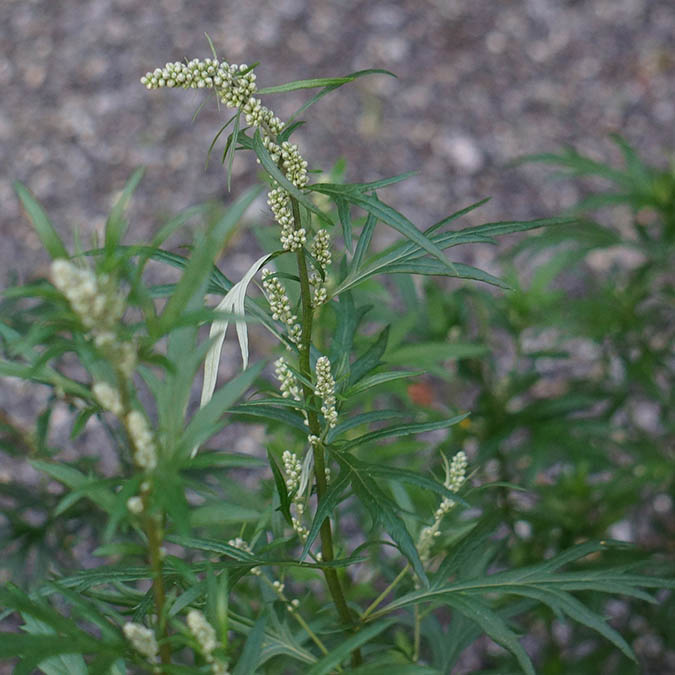
Image by Merja Partanen from Pixabay
You can easily purchase mugwort seeds and grow her yourself to take advantage of her benefits. But chances are that she might be growing in your backyard already. Truth is, she grows all over temperate Europe, Asia, Africa, and even some parts of Alaska.
You’ll find the mugwort flower growing in fields, in uncultivated soils, and along waysides and waste lands. Although she is considered an invasive weed in some parts of North America, you really want to get to know this tall lady a lot better considering all of her interesting properties.
Poison Hemlock Look-Alike?
Wait a minute. Doesn’t mugwort look a lot like poison hemlock? Not really. However, as with any plant, you should be 100% sure of identification. Here are 5 major differences:
- Hemlock plants can grow as much as 10–12 ft. high, while mugwort only grows to 4 ft. While I’ve met some mugworts as tall as 5–6 ft., I’ve certainly not seen any that were 12 ft. tall.
- Hemlock has white flowers with 5 petals that are arranged in umbrella-shaped clusters, while the mugwort flower is smaller, pale yellow or reddish, and arranged in groups on a raceme.2)Raceme: An arrangement of flowers along a stem in which the flowers grow singly on short stalks that are arranged equally along the stem. The flowers open in succession from bottom to top.
- Hemlock’s central stem is green with purple splotches, while mugwort’s stem is all purplish in color.
- Hemlock has toothed, fern-like leaves, while mugwort’s leaves are pinnately lobed with the underside of the leaves featuring a downy, silvery sheen.
- When crushed, hemlock leaves have a musky odor reminiscent of mouse urine, while mugwort’s leaves have a pleasant smell reminiscent of sage and chrysanthemum.
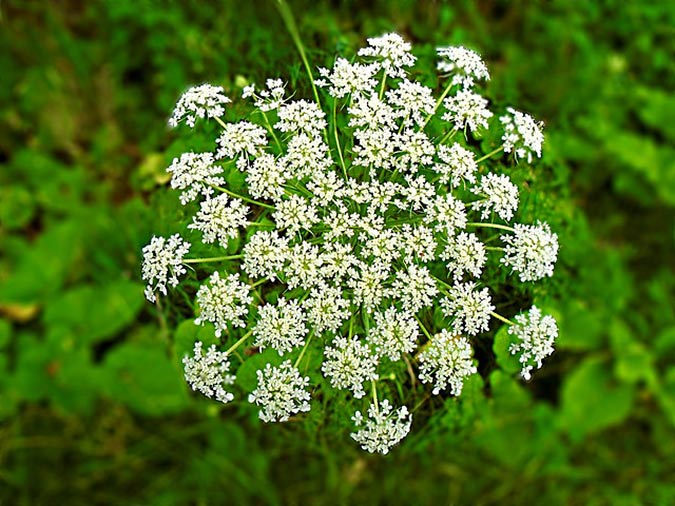
Hemlock (Conium maculatum) flowers are white and grow in umbrella-shaped clusters.
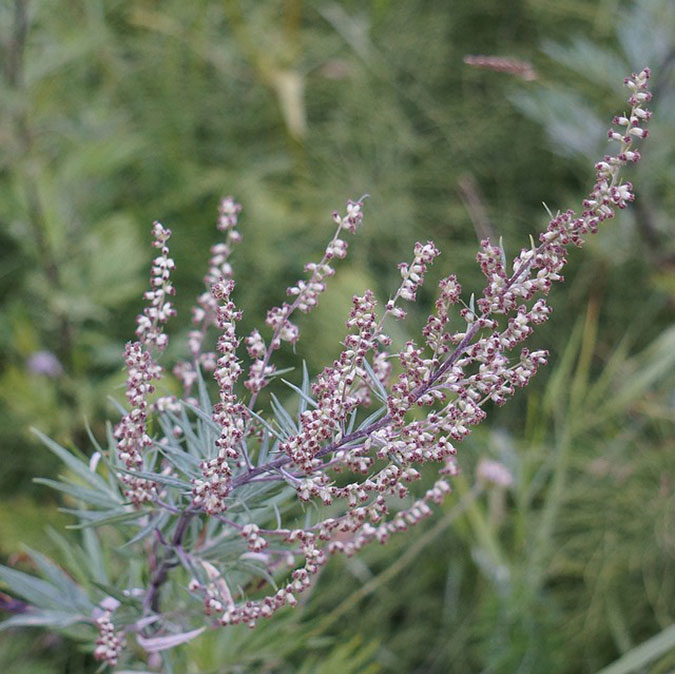
Mugwort (Artemisia vulgaris) flowers are pale yellow or reddish in color and grow in racemes.
7 Edible and Medicinal Mugwort Uses
Now let’s look at the many interesting edible and medicinal uses of mugwort—the reasons why this wonderful lady is a sure keeper.
#1: Flavorful as a Bitter Aromatic
On the edibility scale, she’s considered a bitter aromatic, which means she helps to get the liver juices flowing. Some don’t mind her raw, so if you are keen on her taste, you can add a few of her leaves and flowers to salads. Others prefer her leaves and flowers in soups and stews, much as you would use flavorful herbs like cilantro, dill, or parsley.
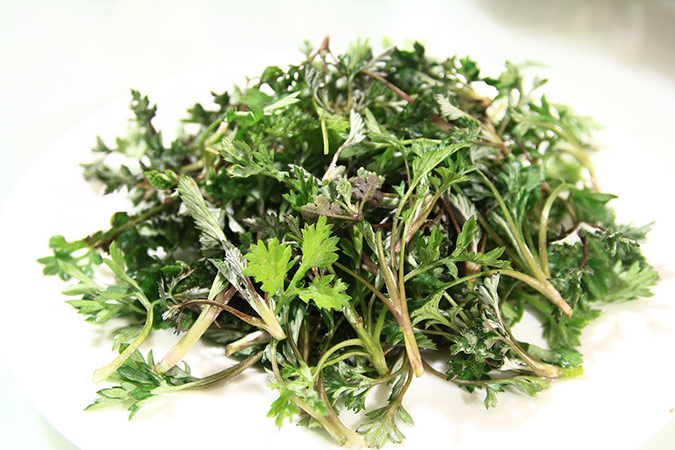
Image by cheolhan jo from Pixabay
Don’t Miss This —> In TGN’s exclusive Bitters eCourse, learn about these beneficial staples in your home apothecary. Though they are commonly known to be found in drinks, bitters are also an essential first aid tool for gut health, immunity, and inflammation. In this short eCourse, you will learn what it takes to create your own bitters, allowing you to stock your cabinet full of medicinal goodness.
Along a similar vein, you can add some of her leaves and flowers as you would other herbs to flavor rice and grain dishes, fish, meat, and poultry—and even deviled eggs. If you’re into green juices and green smoothies, you can add in a small handful of leaves and flowers along with other greens and fruits.
#2: Tea Substitute? Tea Medicine!
Interesting tidbit: Back in WWII, when tea became a pricey luxury, mugwort was used as a tea substitute in some parts of England. Nowadays, we know that a pot of mugwort tea holds several cups of medicinal mugwort benefits to help with gas, stomach acid, bile production, and overall digestion. Her root is considered a supreme stomachic.

Image by Myriams-Fotos from Pixabay
That same cup of tea can be enjoyed as a nightcap before bedtime since mugwort also has nerve-soothing properties. She might even bring you some lucid dreams.
Mugwort uses also include star status as an emmenagogue, antispasmodic, and hemostatic, which means 1–3 cups of tea a day will help women with menstrual cramps or those who have heavy, prolonged bleeding.
How to Harvest Mugwort
Cut off the top 1/3 of the plant when mugwort is in flower. You can hang the plant upside down to dry (such as from an indoor clothesline), or chop her into small pieces and spread her onto newspaper or on mesh sheets in a dehydrator.
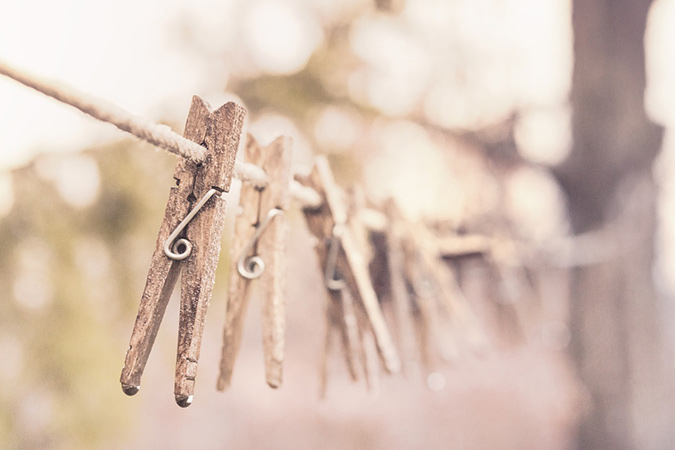
Image by Ryan McGuire from Pixabay
Roots are dug up and collected in the fall. Use a scrub brush and a bit of water to clean the roots, then spread them out on newspaper or on mesh sheets in the dehydrator and let them dry completely. All parts of the plant should be stored away from light (e.g., in paper bags).
You May Also Enjoy:
“How to Make Herbal Infusions”
“Oatstraw Benefits: Stress Reliever, Love Potion, Brain Booster, and More”
“Calendula: Lymph Mover, Detoxifier, Cancer Fighter, and Skin Beautifier”
To Make Mugwort Tea:
Place 1 oz. dried mugwort in 4 cups of boiling water and let steep 5–10 minutes, then strain. If you let it sit for longer and make a standard infusion in a mason jar for 4 hours, the tea will be quite bitter.
Feel free to halve this recipe if you want to make less tea. Keep any unused tea in the fridge for up to 2–3 days.
To Make Mugwort Root Tea:
Place 1 oz. chopped roots with 4 cups water in a glass or ceramic pot. Bring to a boil, then continue to simmer, covered, until reduced by half, about 20–30 minutes. Strain and drink.
To Make Tincture of Mugwort:
If you’d like a taste of mugwort benefits, but you want to skimp on the bitter, consider taking her as a mugwort tincture instead. It’s easy to make your own.
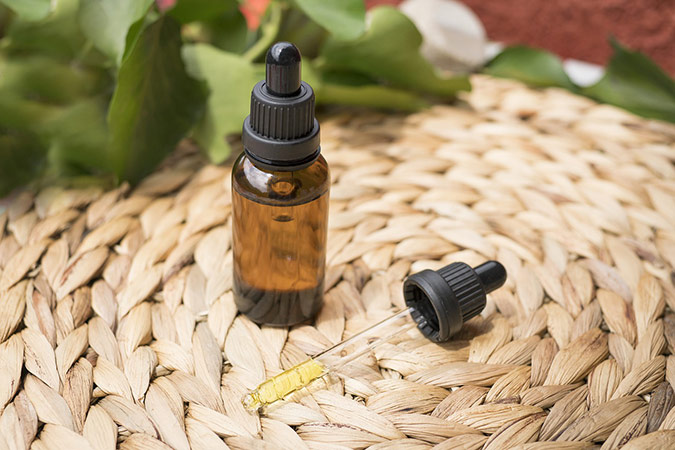
Image by Erin Stone from Pixabay
Cut off the top 1/3 of flowering mugwort plants, and chop the stems, leaves, and flowers into small pieces using scissors or pruners. Place slightly packed in a mason jar. What size mason jar you use depends on how much herb you have.
Fill the jar with alcohol, screw the lid on, and let sit for 6 weeks in a cool, dry place. Strain, and store in dark, amber-colored bottles.
Standard dosage is 5–20 drops. Use this tincture before meals to help with stomach acid and liver bile production or after meals to help with gas, bloating, and distension.
#3: Parasites, Be Gone!
Mugwort is in the same family as wormwood (Artemisia absinthium), and both are great at ridding the body of parasites and candida, including Staphylococcus aureus, Bacillus typhi, B. dysenteriae, streptococci, E. coli, B. subtilis, and pseudomonads. While you can drink the tea for this purpose, you can also try a mugwort retention enema in combination with other naturopathic treatments.

Image by Arek Socha from Pixabay
Yes, folks, you read about mugwort enemas first on The Grow Network!
To Make a Mugwort Enema:
Put 1 liter of slightly warm, finger-hot mugwort infusion* in a 2-liter enema bag. Lie on your right side, making sure that the nozzle has been well lubed, and hold in the mugwort infusion for 10–15 minutes. Candida/parasite cleanses work well on 10-days-on/5-days-off cycles, so use the mugwort enema for 10 days on, then take 5 days off. You can then repeat for another 10 days using the mugwort enema, or do a rotation and opt for other parasitic herbs used for retention enemas.
Commonly used herbs include pau d’arco, wormwood, and black walnut hulls. Since mugwort is in the daisy (Asteraceae) family, this would not be a suitable option for those with ragweed allergies.
*To Make a Mugwort Infusion:
Place 1 oz. of dried mugwort and 4 cups boiling water in a 1-liter mason jar. Screw on the lid, let steep for 4 hours, and then strain.
#4: Dream a Little Third-Eye Dream
Mugwort is said to open the third eye and to spark vivid dreaming, so let’s get to making a dream pillow! Yours can be as simple as filling a sock with dried mugwort leaves or as fancy as stuffing the dried leaves into an embroidered silk sachet. A cotton or organza bag works just fine too.
Simply place your dream pillow underneath your head pillow, and dream away! You can add some dried lavender in with the mugwort leaves to help ease you into peaceful slumber.
#5: Mugwort Clears the Bad Air
Science has officially recognized what folk medicine has known for centuries. Burning herbs to “clear the energy” does just that: It kills bad bacteria lingering around.
Mugwort benefits include its antimicrobial properties, so whether you happen to be a health practitioner about to give a healing session (such as massage, Reiki, reflexology, etc.), or you just want to purge your house of nasty bacteria, consider using a mugwort smudge or incense.

Image by Hanjörg Scherzer from Pixabay
To Make a Mugwort Smudge:
Working with the fresh herb is best for this. You can use dried branches instead, but be aware that the dried leaves will create a fine mess when you go about twining them together with string.
Chop off the top 1/3 of the flowering plant. Take off the smaller branches, and lay them with the flowers at the top and the cut ends at the bottom. Trim the cut ends so that the pieces are about the same length.
Take some cotton string and wrap the ends together, winding several times. Make a knot to secure the string in place. Then continue wrapping the branches together, working up toward the flowery end. The string might have a zigzag look, but don’t worry! Finish by wrapping the flower end several times, then cut the string and secure it with a knot.
Now let the smudge dry—drying will take some time.
You May Also Enjoy:
“A No-Nonsense, Illustrated Guide to 49 Botanical Terms”
To Use a Mugwort Smudge:
While holding the cut-stems end, light the opposite (mugwort flower) end. Hold the smudge over an ashtray or other non-flammable object to collect the ashes, and walk around the room, letting the mugwort smoke bring her clean, grounding energy. Do keep an eye on the smudge while you are doing this!
To put out the smudge completely, douse the lit end in a mason jar filled with baking soda. You can reuse the smudge if you like. You can also burn mugwort as an incense by placing a small bit of a dried branch in a nonflammable object like an incense holder and lighting the branch at the flowering tip.
Smudge rooms seasonally or as needed. Try smudging before meditation or burning mugwort as incense during meditation.
#6: Remineralize With “Strong Bones Vinegar”
A great way to get some of the calcium and magnesium required for strong, healthy bones is by using mugwort vinegar. You can make “strong bones vinegar” at home by lightly packing a mason jar of any size with fresh mugwort leaves and adding apple cider vinegar to fill the jar. Screw the lid on, and let it sit for 6 weeks before straining.
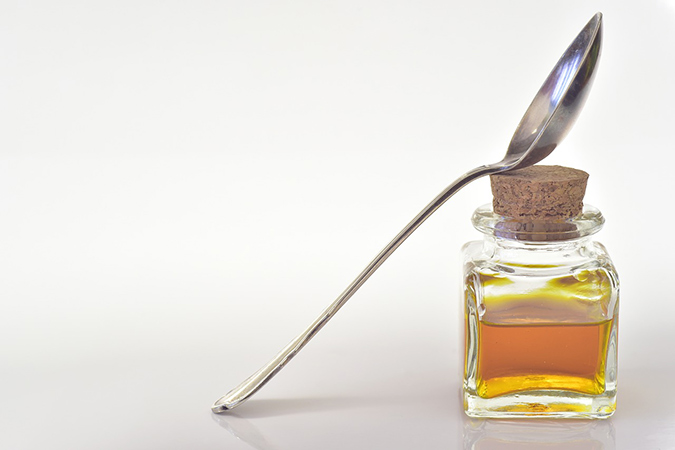
Image by Ulrike Leone from Pixabay
As the leaves soak up the vinegar, you can add in more vinegar as needed. You can use plastic wrap or parchment paper to keep the metal lid from coming in contact with the vinegar and rusting. The apple cider vinegar will leach out the calcium and magnesium from the mugwort’s leaves. Some people like to shake the bottle on a daily basis, checking to see if any more vinegar is needed.
You May Also Enjoy:
“19 Remarkable Benefits of Stinging Nettle”
If you’re like me (too busy or too lazy) and only check it occasionally, your vinegar will turn out just fine anyway so long as you leave it in a cool, dry place out of direct light.
Pour this vinegar over salads or add it to vinaigrettes. (See, mugwort benefits can taste good too!) If you use an apple cider vinegar “with the mother,” you will get the benefits of gut-friendly probiotics as well. And if you like this “strong bones vinegar,” try pairing the mugwort with chickweed (Stellaria media) or nettles (Urtica dioica), or use all three together to make a potent herbal bone vinegar.
#7: Natural Insecticide Help
You can grow mugwort as a companion plant to dissuade aphids and other bothersome insects in the garden. However, since she can inhibit the growth of nearby plants, consider keeping her in a pot. She grows very well in containers and can easily attain 2 ft. in height. Another idea you can try is to use a weak mugwort tea to spray on infected plants as a natural insecticide.
You May Also Enjoy:
“This Natural Bug Repellent Is As Effective As DEET!”
A Few More Ways With Mugwort
Still not sold on how mugwort benefits can improve your life? You might be when you consider these other mugwort uses that you can research further on your own (especially that last one):
- Use mugwort stalks or leaves for kindling.
- Add dried mugwort to a fire to help keep it smoldering.
- Rub mugwort leaves on skin as an antidote to poison oak.
- Since mugwort is an insect repellent, try adding essential oil of mugwort with other essential oils (such as neem, thyme, fennel, lemon eucalyptus, and others) to a carrier oil (such as coconut oil) to make your own natural insect repellent. Try using 20 drops total essential oils to 1 oz. carrier oil.
- Infused mugwort oil can be used to aid in circulation, such as on varicose veins.
- If you’re an acupuncturist/acupressurist, consider making your own moxa sticks from mugwort (how-to instructions can be found on the Internet).
- Make mugwort beer. Mugwort was used in beer recipes before hops became the standard. Look for recipes for “gruit ale” on the Internet.
Note: Large amounts and prolonged use of mugwort can cause nervous system and liver damage. While some midwives might use mugwort to help induce labor, mugwort is not suitable for pregnant or lactating women. Mugwort’s flowers contain pollen, which can trigger hay fever symptoms in those susceptible. Contact dermatitis has been reported by some.
What Do You Think?
What are your favorite mugwort uses? If you are privvy to any mugwort benefits not listed above, let us know in the comments below!
_____________________________
This is an updated version of an article that was originally published on October 5, 2015. The author may not currently be available to respond to comments; however, we encourage our Community members to chime in to share their experiences and answer questions!
Psst! Our Lawyer Wants You to Read This Big, Bad Medical Disclaimer –> The contents of this article, made available via The Grow Network (TGN), are for informational purposes only and do not constitute medical advice; the content is not intended to be a substitute for professional medical advice, diagnosis, or treatment. Always seek the advice of a qualified health care provider with any questions you may have regarding a medical condition. If you think you may be suffering from any medical condition, you should seek immediate medical attention. You should never delay seeking medical advice, disregard medical advice, or discontinue medical treatment because of information provided by TGN. Reliance on any information provided by this article is solely at your own risk. And, of course, never eat a wild plant without first checking with a local expert.
The Grow Network is a participant in the Amazon Services LLC Associates Program, an affiliate program designed to provide a means for our team to earn fees for recommending our favorite products! We may earn a small commission, at no additional cost to you, should you purchase an item after clicking one of our links. Thanks for supporting TGN!

Cat Wilson is a holistic health practitioner who loves plants and meditation. When she isn’t working out or writing, you can find her hugging trees and talking to the wild weeds in her garden. Grab a gluten-free recipe or get some help with going vegan or mindfulness at her website or on her YouTube Channel: Cat’s Raw Paw.
References
| ↑1 | Pinnate: Literally meaning “resembling a feather.” It can refer to leaflet arrangement or a venation pattern. |
|---|---|
| ↑2 | Raceme: An arrangement of flowers along a stem in which the flowers grow singly on short stalks that are arranged equally along the stem. The flowers open in succession from bottom to top. |
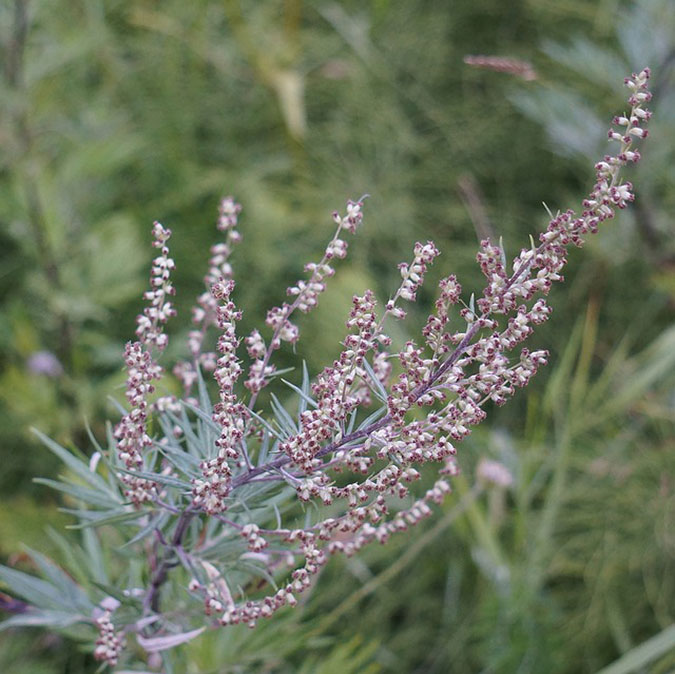
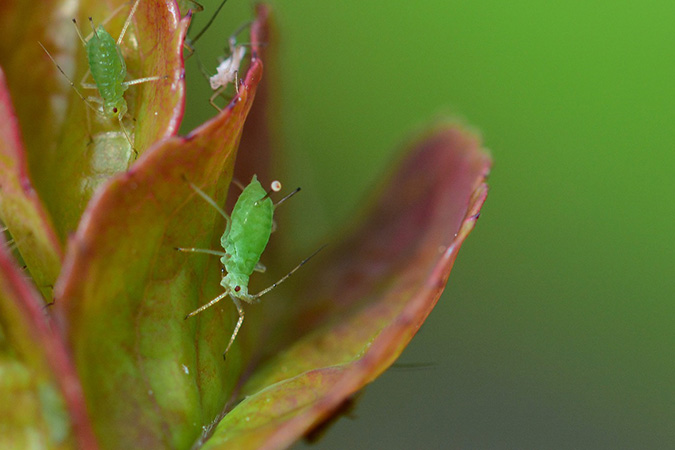







COMMENTS(29)
I had a yard full of mugwort when I lived in NJ but didn’t make much use of it. I think Susun Weed first gave it the name cronewort in one of her Wise Woman books.
She’s a keeper, whatever her name is! Yes, Susun Weed is fond of calling her cronewort 🙂
We lacto-fermented some veggies adding mugwort as a “spice” – we tried a mugwort/juniper berry and a mugwort/mint combo. Both are delicious. I don’t care much for the taste of mugwort in tea, but i absolutely love its scent. The fermentation tastes like the scent.
Following your suggestion, I’m going to brew up a large batch of mugwort beer, both for beer and to make a vinegar from scratch out of. Thanks for the tip.
It’s a magic plant for sure. Our place is surrounded by mugwort and it feels protected in some way.
So glad you were able to make use of the article! Hope the beer recipe turns out fantastic 🙂
want to try the fermenting tip!
I grew what was called wormwood/artemisia vulgaris several years ago in a more southerly location. I now live quite a bit farther north, and am encourage to grow it again. A use you did not mention was that if mixed in a dry or wet arrangement it will inhibit formation of mold. One precaution I wished I had known about was that in addition to the risk of inhibiting the growth of some plants, it started to spread vigorously in its second year. It is an attractive bush and I didn’t want to eliminate it, but it was a real fight to keep it cut back enough to give my other plants space to grow. It didn’t seem to inhibit my cucumber plants beyond climbing into their space. Growing in a pot or well outside the garden would work. The deer have no interest in it. Thanks for the excellent suggestions and specific instructions. I already relish nettles, have plenty of chickweed and am going to try the bone replacing vinegar. Sandy
Hi Sandy,
Thanks for your feedback on the article! I am happy you enjoyed it! Yes, Wormwood and Mugwort are in the same family, although you will see that while they are similar, they are nevertheless two different plants.
Mugwort, as you have seen, can be quite aggressive in the garden. But, as you pointed out, it depends what she’s growing beside. I had Mugwort growing with Sheep Sorrel in a pot, and it was the sorrel that won out!
I did mention that you can use Mugwort root for medicine. In fact, I made a tincture of the root just yesterday. You might want to give this a try when digging up the “excess” plants!
Good luck with the Mugwort vinegar 🙂
Thanks for the further detail and the encouragement.
I can’t resist going slightly farther off the trail. You mentioned that sheep’s sorrel can overwhelm mugwort. This is one persistent weedy herb! It wandered into my first try at hugelkultur and has astonished me with it’s capacity to spread. It makes for fascinating weeding–sends a thin root with a tiny, juvenile leaf tip shooting under unfriendly territory for long distances, I mean 2-1/2 to 3 feet and counting. When it finds an acceptable spot it bursts to the surface and rapidly forms a cluster of leaves and roots that rapidly spread out in more clusters. I had a few shoots work their way through the root mass of my hyssop and they were brutally hard to extract. None of us likes the taste, and I need to avoid acidic foods, so tossing it in the soup with other potherbs is not practical. My hugel pile was thoroughly laced with it before I realized it was a problem. Do you know of any organic strategies beyond relentless excavation to discourage this herb?
Hi Sandy,
I’m not a permaculturist, but here are a few suggestions:
1. sorrel grows in acidic soil, so adjust the soil ph.
2. sorrel likes compacted earth, so aerate.
3. dig up ALL the rhizomes
4. an from my herbalist’s heart, dig up all the roots and USE them! the roots are famous in Essiac tea, which is an anti-cancer tea. The root is an excellent anti-oxidant, anti-inflammatory and immune booster. It’s also high in vitamins A, B, C, D, E and K and is most useful for bacterial infections, including sinus infections, as well as being an excellent stomachic and diuretic.
Even if you can’t use it for yourself, perhaps others can. You can dry the root and then decoct it or use it in a tincture. Others might also appreciate the lemony sourness of the greens. Perhaps selling some at the farmer’s market??
Hope these suggestions have helped 🙂
Hey, Cat! I read your article with more experienced eyes and was surprised o see my initial comments, with only a vague memory that I had read a great article about Mugwort some time ago. Homestead living has moved mugwort way too far down my list of must-do’s. I did plant seeds but got no mugwort. Any tips for maximizing germination and survival? Some herbs are planted by scattering n the Fall. Is it a seed that will go stale quickly? I definitely want to make the “strong bones vinegar” and now have a good patch of nettle as well as plenty of chickweed. to work with. I have the seeds and may be able to make a bach this Fall if enough herbs survive through tonight’s first hard frost of the year. And, by the way, I started a flock of chickens, who like a bit of sheep’s sorrel in their forage, but also experimented with starting a few Jewel strawberries on my apple tree hugel pile, and the amazingly aggressive sheep sorrel has gone very quiet through this past spring and summer, possibly due to the increased shade. It had already migrated to a location about 50 feet away (!) and a colony of it was going strong this Spring! A last note: In my culture, mugwort and several other herbs are traditionally used at New Year’s Day feasts. Mugwort is prominently featured in a kind of soft mochi cake served plain or with azuki filling, as well as in a brothy soup. It is a traditional ingredient in incense for special occasions, and it was interesting to consider the benefits of smudging in that context . Okinawa is semi-tropical, so Spring follows quite soon after the New Year, and the feasting is a good opportunity to cleanse and refresh for the had work of the coming year.
I really enjoyed all the tips for using Mugwort, from both the article and the comments. I live on land that is hard to cultivate, and am introducing edible herbs (weeds) each year, and will be adding Mugwort to my list. I want to make both a tincture, and the vinegar.
Hi Sunny!
I am so glad that you enjoyed the article! As I mentioned in another comment, it depends what else is growing beside Mugwort. For example, in the field that I went to today to forage for various plants, Mugwort was but ONE plant that was growing there. I do find that she tends to grow in a little group, although I have seen a sole mugwort growing by herself (with her family a bit farther off). I think if you have a weed garden, growing Mugwort in the ground might be just fine —so long as the other weeds are “pesky” as well, like plants in the mint family, lamb’s quarter, yarrow, wild carrot, sorrels and others. Of course, a container will work just fine for her too 😉
FYI: the root tincture that I made was with BOTH mugwort root and sheep sorrel root. Both are vermifuges and stomachics. Don’t use the sheep sorrel if you have kidney stones!
Thanks again for your feedback 🙂
Raceme, pinnately lobed. If you’re trying to teach people, it might be better if you used plain language.
Thanks, Marc!
It’s hard to decide these things when writing an article, because some people have a lot of knowledge while others are just starting out. There is a certain classification system for plants however (aka botany) which gardeners, permaculturists, herbalists and others can and do use to better describe plants. This really helps when IDing plants.
I’m not a botanist and I do understand where you’re coming from 🙂 I’d suggest looking up those words —there are many plants that grow in umbels vs. racemes.
At first you might be thinking, now just what do those words mean?! And the words just mean that plants are arranged in different ways. There are actually comparative charts that you can find online and in field guide books which give you a great visual comparison of how plants are arranged.
The fun comes when you decide to apply your knowledge and start noticing the plants around you, how they all seem to have a different pattern about them. You take out that comparison chart and you say, “Aha! Raceme!” And there’s your first classification of a plant!
I know botany terms can be “pesky,” but you’ll see that those classification terms can come in real handy. Just think of those words as new words you never heard before 🙂 and perhaps take up the challenge to find out more 🙂
I loved the article and like that you didn’t describe every botanically sciency word. I think it’s better for people to learn what the words mean by finding the description. Plus the article would be way too wordy if you tried to define every word that you think someone may not know the meaning of. Also, these terms are important in making sure people know the exact plant you’re writing about, especially when concerning medicinal use. All terms are easily googled anyway.
wow. Three smiley faces.
We’ll inevitably get used to being more specific about discussing herbs. Just think about how strange the concept of ‘detoxifying” was to our parents. They knew what parasites were, and thought they had become too modernized to worry about them! Hah! I wish I had a liver as strong as my Mom and Dad’s!
Thank you Mark, I have to agree about the technical terms. I appreciate learing them but no one ever seems to want to define them so I can understand what I’m reading, although here in this blog it wasn’t so bad, I only have to hit the dictionary on a few. Another point to ponder is the pictures, the plants are so far away you really can’t SEE the difference between the leaves (this would have illustrated your technical description ad saved another trip to the dictionary). Otherwise, I’d like to thank you Cat for the well written and valuable information you share, those who have responded and shared even more info and ideas, and the [Grow] Network for so much good and usable info.
Great article. Wish I knew what this plant was before I painstakingly removed (most of) it from my garden. I’m sure it’s still there though since the rhizomes easily break when trying to pull em up. Not that it would have stopped me but at least I would have gotten use of them.
I have started growing mugwort. And have been purchasing dried from a store in town. I have a lot of questions about harvesting my mugwort when it is grown. If somebody could help please reply to this and we can speak. Thanks!
what are your questions, Jeff? sounds like it could be a lot of fun!
Can’t wait to try it as a smudge stick. Thank you
This was right up my alley. Loved it.
Great info. Thanks for posting this article.
great article on a plant I know nothing about but will be growing as soon as I find seed! We buy smudge sticks and to make one will be fun not to mention using it for tea. It sounds so medicinal; I can’t wait
Hi, you can probably find it growing wild and transplant some into an area of your yard. I really don’t recommend it in your garden, because it likes to spread and kick other plants our of its path–a bit assertive for a garden space. But if you have someplace for it to spread, it is a lovely plant to have and to use!
Looks like I should look around to see if there are any plants growing wild around me and if not, I need to plant a patch!
Mugwort is on of my most favorite plants. However, she has been banned from my garden as she grows in such profusion all around where I am, and she is a bit, well, assertive in the garden. More than anything else, mugwort grows by root extension and can grow quite a patch of herself, pushing everything else out of her way.
My favortie use for mugwort is in herbal wreaths.
Very informative article